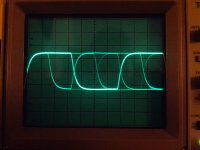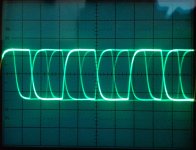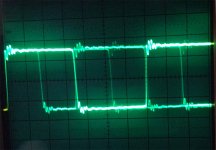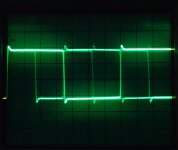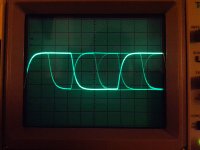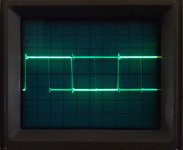Hi,
on a TASCAM CD-401 MkII here is what the S/PDIF looks like. It does sync flawlessly but I wonder if the signal's shark fin look can be, or even needs, to be improved. If for you guys rise/fall edges are just good enough I will not mess with the passive parts after the 74HC04.
Thanks!
on a TASCAM CD-401 MkII here is what the S/PDIF looks like. It does sync flawlessly but I wonder if the signal's shark fin look can be, or even needs, to be improved. If for you guys rise/fall edges are just good enough I will not mess with the passive parts after the 74HC04.
Thanks!
Attachments
not sure, looks more like the toslink trace at the end, in his words "bad bad bad. It is a miracle the DAC reads and understands this crap", but I might be wrong
The TosLink one has no flat top and bottom, it's not that ugly 😉 Mine looks a bit less square that his screen captures because our scopes were not on same time/div.
As I have resistors, caps and transformer maybe I can try it... but the L just at the output of the 74HC04 makes me wonder, filtering noise? If yes, will the transformer will remove some?
As I have resistors, caps and transformer maybe I can try it... but the L just at the output of the 74HC04 makes me wonder, filtering noise? If yes, will the transformer will remove some?
The TosLink one has no flat top and bottom, it's not that ugly 😉 Mine looks a bit less square that his screen captures because our scopes were not on same time/div.
true dat
Same scale as Lampiz', looks better 🙂 But still shark-like.
Will try my Murata DA101C, before it a 100nF cap and after a L pad 360R/91R to BNC.
Will try my Murata DA101C, before it a 100nF cap and after a L pad 360R/91R to BNC.
Attachments
Last edited:
The rise time looks to be around a third of the bit time. If you were to speed up the rise time you'd get lower jitter but the downside is you'd get worse reflections if you don't perfectly terminate the cable. I'd leave it alone, its a reasonable compromise as it is 🙂
Thanks Richard,
by reflections you mean what kind of visible things? My other sources have faster rise/fall but show some ringing on the top/bottom. (all measure are with 75R load or the real load).
On this very CD player it's an inductance that slow it down, if I bypass it (it's just after the 74HC07) I get a more classic shape, with some light ringing. In fact each of the scope I've used... shows different ringing levels! Maybe even the scopes have hard times with square signal?
Here is my TEAC for comparison. Maybe you are right about leaving things as they are, they all sound and work well, I just wanted to know if there was any improvement possible where it seems to matters, jitter. And that galvanic isolation thing... the more I learn the more I see how much I don't know :'( But now I'm scared m TEAC's S/PDIF is not that great! =)
by reflections you mean what kind of visible things? My other sources have faster rise/fall but show some ringing on the top/bottom. (all measure are with 75R load or the real load).
On this very CD player it's an inductance that slow it down, if I bypass it (it's just after the 74HC07) I get a more classic shape, with some light ringing. In fact each of the scope I've used... shows different ringing levels! Maybe even the scopes have hard times with square signal?
Here is my TEAC for comparison. Maybe you are right about leaving things as they are, they all sound and work well, I just wanted to know if there was any improvement possible where it seems to matters, jitter. And that galvanic isolation thing... the more I learn the more I see how much I don't know :'( But now I'm scared m TEAC's S/PDIF is not that great! =)
Attachments
Yeah reflections are visible as either a non-continuous rise/fall - steps in other words, and perhaps steps on the tops/bottom of the waveform. But it depends on the time delay associated with the reflection - with a very short delay it could look just like ringing.
Your scope would need a low inductance earth connection for you to be sure of the shape of a fast waveform, a few cm of earth wire with fast edges can introduce ringing.
As the output is 'shaped' by an inductor, you could try reducing the value (try half) of that component and see if you get any audible improvement.
Your scope would need a low inductance earth connection for you to be sure of the shape of a fast waveform, a few cm of earth wire with fast edges can introduce ringing.
As the output is 'shaped' by an inductor, you could try reducing the value (try half) of that component and see if you get any audible improvement.
As the output is 'shaped' by an inductor, you could try reducing the value (try half) of that component and see if you get any audible improvement.
Ok I'll keep this one for the next time I open it then, don't have the service manual nor the L value and I'm lazy enough to keep your first advice of leaving it as is for now =)
Still will do that transformer output to see how it looks.
Your scope would need a low inductance earth connection for you to be sure of the shape of a fast waveform, a few cm of earth wire with fast edges can introduce ringing.
Tested that with the same source post #9, my TEAC player, but done with coax cables only (75R coax from source to a 75R on coax plug and 50R coax to scope). Not the same! Better measurement? (#9 was at the DAC's input and with a... decent chinese probe and its crocodile clip).
Measurements are also fine arts...
Attachments
Tascam's passive, post logic IC, S/PDIF circuitry out, tiny pcb with cap/transformer/R divider in. No probe but full coax like done previous post to check it out.
That is square! And also isolated. Good enough!
Pics: factory and modded.
That is square! And also isolated. Good enough!
Pics: factory and modded.
Attachments
Last edited:
Tascam's passive, post logic IC, S/PDIF circuitry out, tiny pcb with cap/transformer/R divider in. No probe but full coax like done previous post to check it out.
That is square! And also isolated. Good enough!
Pics: factory and modded.
Malefoda: And how a about the TASCAM CD-401 MkII remote control, which makes the CD Player/CD Transport so easy to use? Looks like it doesn't have one, other than a wired one...
They are the same as Teac VRDS ones, codes are the same. I use a programmable ChunGhop remote to learn the codes from my VRDS-10. Works great! I guess you can find an used Teac VRDS remote if not sold with.
https://www.sunsky-online.com/p/S-TT-1006/ChunGhop-Universal-Learning-Remote-Control-L102-White-.htm
Maybe universal remotes with a list of ready brands codes are still sold.
https://www.sunsky-online.com/p/S-TT-1006/ChunGhop-Universal-Learning-Remote-Control-L102-White-.htm
Maybe universal remotes with a list of ready brands codes are still sold.
I've been lucky enough to grab a Tascam CD-401 MKII for a few amount of euros! I also have a TEAC P-700, and after some comparisons (always with the same DAC with PCM63J) I dare to say that Tascam is better than TEAC. What a great sounding transport, even in stock mode, and also not bad as CD player!
The XLR polarity on the Tascam 401 mkII is Pin2 Cold, Pin3 Hot. On my Electrocompaniet EC 4.8 preamp i have Pin2 Hot, Pin3 Cold. Would this matter?
- Home
- Source & Line
- Digital Source
- TASCAM CD-401 MkII S/PDIF: good enough?
